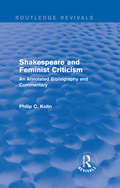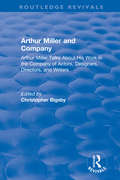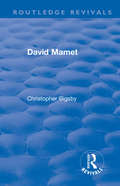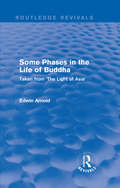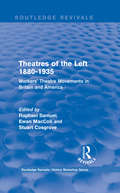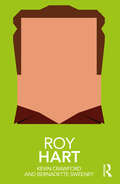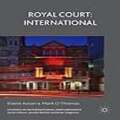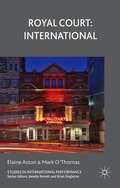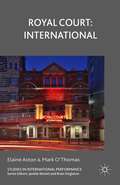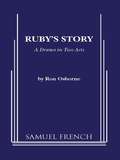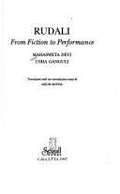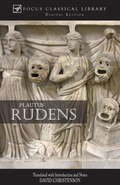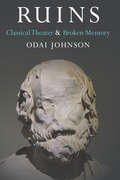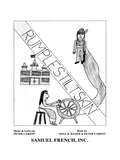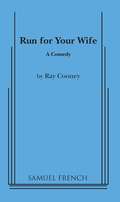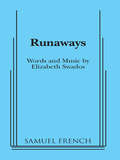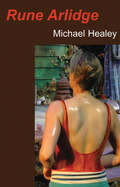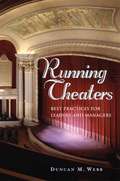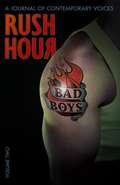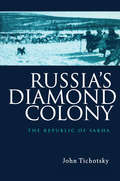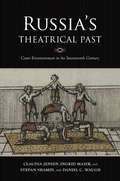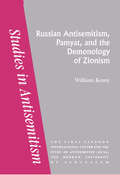- Table View
- List View
Routledge Revivals: An Annotated Bibliography and Commentary (Routledge Revivals)
by Philip C KolinFirst published in 1991, this book is the first annotated bibliography of feminist Shakespeare criticism from 1975 to 1988 — a period that saw a remarkable amount of ground-breaking work. While the primary focus is on feminist studies of Shakespeare, it also includes wide-ranging works on language, desire, role-playing, theatre conventions, marriage, and Elizabethan and Jacobean culture — shedding light on Shakespeare’s views on and representation of women, sex and gender. Accompanying the 439 entries are extensive, informative annotations that strive to maintain the original author’s perspective, supplying a careful and thorough account of the main points of an article.
Routledge Revivals: Arthur Miller Talks About His Work in the Company of Actors, Designers, Directors, and Writers (Routledge Revivals)
by C.W.E. BigsbyFirst published in 1990, this book presents a discussion with Arthur Miller, in conversation with Christopher Bigsby. Miller talks openly and extensively about his own life and experiences, events and environments which provide material for his plays: his New York childhood, the Depression, the McCarthy witch-hunts. He discusses in depth both the technique of his writing and the moral and political questions which his plays address, and argues passionately for the importance of maintaining respect for human values in a world where they are so frequently transgressed. Interwoven with these conversations are contributions from actors, directors, designers, reviewers, and writers who have encountered Miller over the years – whether in person or through his plays – which attest to the universal and enduring importance of his work.
Routledge Revivals: David Mamet (Routledge Revivals)
by Christopher BigsbyFirst published in 1985, C.W.E Bigsby examines the career and work of playwright David Mamet. Bigsby shows that Mamet is a fierce social critic, indicting an America corrupted at its core by myths of frontier individualism and competitive capitalism. Mamet has created plays whose bleak social vision and ironic metaphysics are redeemed, if at all, by the power of imagination. No American playwright before him has displayed the same sensitivity to language, detecting lyricism in the brutal incoherencies of every day speech and investing with meaning a contemporary aphasia. Few have offered dramatic metaphors of such startling and disturbing originality. Bigsby’s study is the first book to provide a thorough account of David Mamet’s life and career, as well as close analyses of individual plays.
Routledge Revivals: Taken from 'The Light of Asia' (Routledge Revivals)
by Edwin ArnoldFirst published in 1915, this book presents a dramatization of part ofthe author's The Light of Asia. The original text represents one of the first successful attempts to popularise Buddhism and its founder Gautama Buddha — presenting his life, teachings and philosophy in verse poetry. This adaptation dramatizes part of the The Light of Asia and includes staging instructions, properties required, illustrative drawings of suggested costumes, and incidental music composed specifically for the piece. This book will be of interest to students of Indian and Buddhist literature — and how this has interacted with the West — as well as students of drama.
Routledge Revivals: Workers' Theatre Movements in Britain and America (Routledge Revivals: History Workshop Series #5)
by Raphael Samuel Stuart Cosgrove Ewan MaccollFirst published in 1985, this book examines how workers theatre movements intended their performances to be activist — perceiving art as a weapon of struggle and enlightenment — and an emancipatory act. An introductory study relates left-wing theatre groupings to the cultural narratives of contemporary British socialism. The progress of the Workers’ Theatre Movement (1928-1935) is traced from simple realism to the most brilliant phase of its Russian and German development alongside which the parallel movements in the United States are also examined. A number of crucial texts are reprints as well as stage notes and glimpses of the dramaturgical controversies which accompanied them.
Roy Hart (Routledge Performance Practitioners)
by Bernadette Sweeney Kevin CrawfordRoy Hart’s revolutionary work on the human voice through extended vocal technique and the Wolfsohn-Hart tradition has influenced several generations of practitioners. Hart’s outstanding contribution to vocal research, practice and performance stretched over 20 years until his untimely death in 1975, and his vocal training produced performers with extraordinary and highly expressive vocal ranges. He founded a theatre company, Roy Hart Theatre, that brought his ideas to realisation in ground-breaking works. His influence, through his own use of the voice for theatre and music and its embodiment in his company, was widespread, attracting the interest of directors such as Peter Brook, Jerzy Grotowski and Jean-Louis Barrault. This book combines: a detailed biography giving the social and artistic context of Hart’s work and that of the early Roy Hart Theatre an exploration of Hart’s own writings on his work, combined with a review of articles by his wife Dorothy Hart and in-depth interviews a stylistic analysis of his key works, including The Bacchae, and, L'Economiste and Biodrame, and their critical reception pathways into some of the practical exercises devised by close collaborators of Roy Hart and practitioners of the Roy Hart Theatre Tradition. As a first step towards critical understanding, and as an initial exploration before going on to further, primary research, Routledge Performance Practitioners offer unbeatable value for today’s student.
Royal Court: International
by Elaine Aston Mark O’thomasRoyal Court: International is the first full-length study of the Royal Court Theatre's International Department. It charts the engagement of the UK's premiere theatre for new writing with an internationalist agenda and takes readers inside the process developed by the Court for the workshop projects it has undertaken in different parts of the world since the late 1990s. Covering the theatre's unique programming of international plays and seasons, it highlights new writing from different parts of the globe, including France, Spain, Germany, Russia, Eastern Europe, Brazil, Cuba, Mexico, Columbia, Iran, the Near East, North Africa, Nigeria and India. First-hand accounts of the work appear in contributions from Stephen Daldry, Elyse Dodgson and Vicky Featherstone, and in interviews with Marcos Barbosa (Brazil), Anupama Chandrasekhar (India), Dominic Cooke, Sasha Dugdale, Marius von Mayenburg (Germany), Mark Ravenhill and Indhu Rubasingham.
Royal Court: International (Studies In International Performance)
by Elaine Aston Mark O’ThomasThe first ever full-length study of the Royal Court Theatre's International Department, covering the theatre's unique programming of international plays and seasons, its London-based residences for writers from overseas, and the legacies of workshops conducted in more than 30 countries.
Royal Court: International (Studies in International Performance)
by Mark O'Thomas E. AstonThe first ever full-length study of the Royal Court Theatre's International Department, covering the theatre's unique programming of international plays and seasons, its London-based residences for writers from overseas, and the legacies of workshops conducted in more than 30 countries.
Ruby's Story
by Ron OsborneDrama / Characters: 3m, 6f / June 1944. In England, Allied troops are massing for an invasion. On a small farm in Appalachia, a different kind of war is about to rage. Here, Walter and Grace share a home with four daughters: Rose, who struggles to understand why Stan - an immigrant coal miner and the love of her life - abruptly left to join the Polish Free Forces; Helga, who fears for her husband who's in the Army and - like Stan - assigned to a combat unit in England; Frieda, the family's adventure-seeking daughter, who works in a factory making uniforms and new friends, one of whom she can't bring home; and teenage Ruby who yearns to be the next Edward R. Murrow, but who must first come to grips with a family falling apart at the seams. D-Day speeds the dissolution process. But at its core is Walter's seeming allegiance to his German heritage, no matter that Helga's husband and Rose's fiancé are at war against all things German. There - through every battle - is Grace, hoping liberal doses of humor, love and understanding can restore harmony. It is adult Ruby - back for a funeral, seeking answers to questions that haunt her - who retells the family's struggle against prejudice, fear, delusion and self-loathing.
Rudali: From Fiction to Performance
by Anjum Katyal Mahasweta Devi Usha GanguliRudali means 'hired crier'. It is a Bengali short story by Mahasweta Devi. Also in this book is the Hindi play of the same name that is adapted from the short story by Usha Ganguli.
Rudens: The Rope
by David Christenson PlautusThe play Rudens provides an introduction to the world of Roman comedy from one of its best practitioners, Plautus. As with all Focus translations, the emphasis is on an inexpensive, readable edition that is close to the original, with an extensive introduction, notes and appendices.
Ruins: Classical Theater and Broken Memory (Theater: Theory/Text/Performance)
by Odai JohnsonTheorizing the effects of memory, absence, and disappearance in classical theater—the aesthetics of ruins.
Rumplestiltskin (Larson)
by Peter LarsonChildren's Musical / Flexible Cast / Unit Set / This humorous and enchanting musical brings the classic story to life with delightful songs, dancing, clever dialogue, and even some audience participation. The spirited songs by an awarding winning composer whose works have been recorded by Dionne Warwick and Bette Midler are provided with simple piano accompaniment. This musical is perfect for elementary school classes to perform or for children's theater groups, ages 6 12. Its an absolute charmer for parents or any audience. Cast size may be expanded to as many as 40 and the physical production may be simple or elaborate as conditions permit. Running time is approximately 30 minutes.
Run for Your Wife
by Ray CooneyFarce / 6m, 2f / Interior Set / This superb example of the British farce had them rolling in the aisles in London and New York. A taxi driver gets away with having two wives in different areas of London because of his irregular working schedule. Complication is piled upon complication as the cabby tries to keep his double life from exploding. For a side splitting sequel, see Caught in the Net .
Run, Hide, Fight Back
by April HenryWhen a deadly shooting breaks out in a Portland shopping mall, a diverse group of teens ends up trapped behind a store’s security shutter. To her own surprise, seventeen-year-old Miranda finds the others looking to her as their leader. But she’s hiding a big secret―and she’s not the only one. The group has only three choices: Run, hide, or fight back. The wrong decision will have fatal consequences. In her masterful style, April Henry crafts an unrelenting thriller with empowering teen heroes. For fans of the breakout YA mysteries This Is Where It Ends and One of Us Is Lying.
Runaways
by Elizabeth SwadosRunaways is a collection of songs sung by troubled children. While the subject is primarily runaway children from broken homes, Runaways also comments on the larger world in which the children live. / "Elizabeth Swados makes us eavesdrop on the sufferings of children. That sounds ominous but it isn't...The calligraphy of childhood is one of the wonders of nature even when the message it writes is heartbreaking." - The New York Times
Rune Arlidge
by Michael HealeyA family of women—the eldest incapable of keeping stories to herself, her two daughters on the verge of making life-altering decisions, a granddaughter wise beyond her years. Healey takes us on a 25-year-long trip to the family cottage. A new play by the author of The Drawer Boy.
Running Theaters, Second Edition: Best Practices for Leaders and Managers
by Duncan M. WebbAdvice Culled from Interviews with More Than One Hundred Experts in the Field In Running Theaters, management consultant and author Duncan M. Webb reveals the best practices that consistently lead to successful theater operations. Culled from surveys and interviews with theater managers and experts in crucial functional areas, this guide provides important tips for all people who work or want to work in regional, campus, and community-based theaters. Updated to reflect changes in the field, this second edition includes information on recent programming trends, marketing in the digital age, and the evolving role of theaters in economic and community development. Chapters discuss topics such as:Front- and back-of-house operationsManaging nonprofit and commercial rentersBuilding and managing a board of directorsThe financial management of theatersThe necessary skills and attributes of a successful theater managerThe unique opportunities and challenges of operating historic, outdoor, and campus-based theaters. Every theater manager needs this invaluable guide filled with the proven strategies of managers, staff, and volunteer leaders covering virtually every aspect of running a theater—from drawing audiences and fundraising to facility development and community involvement.
Running Theaters: Best Practices for Leaders and Managers
by Duncan M. WebbThe best practices that consistently lead to successful theater operation are now revealed in this comprehensive resource. Culled from surveys and interviews with theater managers and experts in crucial functional areas, this guide provides important tips for all people who work or want to work in regional, campus and community-based theaters. Proven strategies from managers, staff, and volunteer leaders cover virtually every aspect of running a theater - from audience development and fundraising to facility development and community involvement.
Rush Hour: Bad Boys (A Journal of Contemporary Voices Volume #2)
by Michael CartBold, innovative, and eclectic--that's Rush Hour,the place for thought-provoking stories, essays, art, and poems from today's most distinguished voices, both established and new. "Bad Boys" is the hard-hitting theme of Volume Two. Here are drifters, pranksters, jocks, rebels, monsters, and heroes living life on the edge. In knockout stories by Jackie Woodson and E. R. Frank, artwork by John O'Brien and Chris Gall, essays by Robert Lypsite and Jack Gantos, and much more, bad boys sometimes play by the rules, often misbehave, but always grab our attention. This second issue solidifies the reputation of this unprecedented, pulsating journal, published twice a year and focused on themes today's readers care about most. "Rush Hour is ... a vehicle for sharp, challenging new writing that aims for a discerning and literate young adult audience the way the best literary magazines have long done for older readers."
Russia's Diamond Colony: The Republic of Sakha
by John TichotskyThis study looks at the reform process in Sakha and at a one hundred year history of economic development. The research revealed that Sakha's progress has always been determined by the export of key resources.
Russia's Theatrical Past: Court Entertainment in the Seventeenth Century (Russian Music Studies)
by Claudia R. Jensen Ingrid Maier Stepan Shamin Daniel C. WaughIn the 17th century, only Moscow's elite had access to the magical, vibrant world of the theater.In Russia's Theatrical Past, Claudia Jensen, Ingrid Maier, Stepan Shamin, and Daniel C. Waugh mine Russian and Western archival sources to document the history of these productions as they developed at the court of the Russian tsar. Using such sources as European newspapers, diplomats' reports, foreign travel accounts, witness accounts, and payment records, they also uncover unique aspects of local culture and politics of the time. Focusing on Northern European theatrical traditions, the authors explore the concept of intertheater, which describes transmissions between performing traditions, and reveal how the Muscovite court's interest in theater and other musical entertainment was strongly influenced by diplomatic contacts.Russia's Theatrical Past, made possible by an international research collaborative, offers fresh insight into how and why Russians went to such great efforts to rapidly develop court theater in the 17th century.
Russian Antisemitism Pamyat/De (Studies In Antisemitism Ser. #Vol. 2.)
by CoreyFirst Published in 1995. Routledge is an imprint of Taylor & Francis, an informa company.
Russian Comedy of the Nikolaian Rea (Russian Theatre Archive Ser.)
by Laurence SenelickThese four Russian comedies were written during the reign of Nicholas I, a period of considerable repression and censorship. They represent the most popular genres of the period. Lensky's Her First Night was an immensely popular vaudeville which held the stage for years; Kozma Prutkov's Fantasy is a parody of vaudeville which was banned after one night. Turgenev's Luncheon with the Marshal is a comedy of manners about provincial life, and Saltykov-Schedrin's Pazukhin's Death is a satire of greed and corruption so savage that it was forbidden during the author's lifetime. This collection constitutes a remarkable comic spectrum which will assist in enlarging the English language repertoire with a set of newly available and hightly stageworthy scripts.
